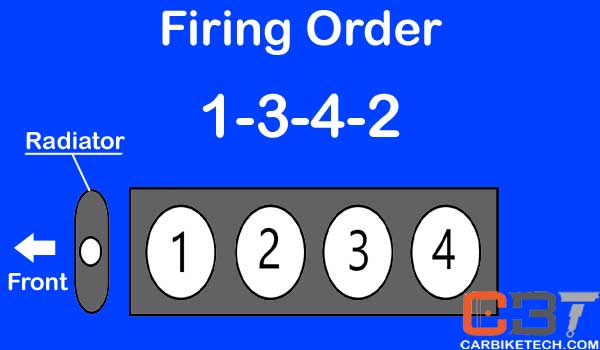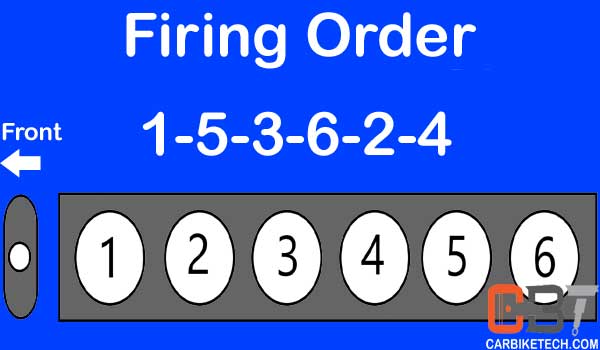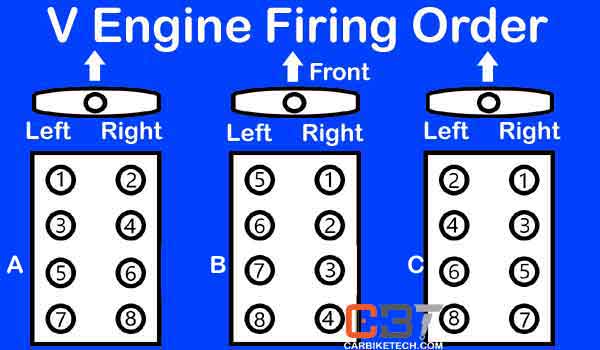Engine Firing Order:
Engines cylinders don’t fire in the sequence of 1-2-3-4-5-6 and so on. It could cause the crankshaft to deform or break. So, manufacturers shuffle the combustion in such a way that it creates power balance in the engine. The order or sequence in which the engine cylinders fire or generate & deliver power is called the engine firing order. The manufacturers designate the front-most or nearest to the radiator as the no.1 cylinder in an in-line engine. Thus, those immediately behind are the no.2, 3, and so on.

The firing order of an engine depends upon the number of cylinders. However, depending upon its design, it may vary from engine to engine. There is no uniform practice for numbering the cylinders in V-type engines. In the case of an in-line engine, the manufacturers designate the cylinder nearest the radiator as no.1. cylinder. Behind it is no.2 and so on. In V engines, the method of numbering cylinders is not uniform. However, generally, it is the 1st on the front right-side bank.
Single & Twin Cylinder Engines:
Single-cylinder engines have only one power stroke for every two crankshaft spins. So, its firing order is 1-1-1-1- and so on. A twin-cylinder engine uses a 180-degree crankshaft. It means the pistons move in opposite directions. When one piston moves up, the other moves down in the cylinder. In this engine, the firing order is 1-2, and so on because the power stroke occurs alternatively.
3-Cylinder Engines:
A 3-cylinder engine has three crankpins 120 degrees apart from each other. In a 3-cylinder engine, the order is 1-3-2, creating power balance in cylinders. It is particularly true in the case of multi-cylinder engines. If all the cylinders fire in the same sequence, it will put excessive stress on the crankshaft from one end. It might result in breakage or twisting of the crankshaft. To avoid it, manufacturers use non-sequential firing orders so that they will run much smoother.
4-Cylinder Engines:
In the case of 4-cylinder engines, the crankpins are 90 degrees apart. So, manufacturers use 1-3-4-2 or 1-2-4-3 as firing order for 4-cylinder engines.
A 4-cylinder engine has the following firing order –
4 cylinder in-line engine – 1-3-4-2
Or 1-2-4-3
4 cylinder horizontally opposed engine – 1-4-3-2
Engine Firing Order 6 Cylinder Engines:
6-cylinder inline engine: 1-5-3-6-2-4
1-4-2-6-3-5
1-3-2-6-4-5
1-2-4-6-5-3

Engine Firing Order of 8 Cylinder Engines:
8 Cylinder inline engine: 1-6-2-5-8-3-7-4
or 1-47-3-8-5-2-6
8 Cylinder V engine: 1-5-4-8-6-3-7-2
1-5-4-2-6-3-7-8
1-6-2-5-8-3-7-4
1-8-4-3-6-5-7-2
1-8-7-3-6-5-4-2
As the number of cylinders increases, the number of possible combinations also varies significantly. American V-8 engines employ three methods of numbering the cylinders. Manufacturers widely use the method shown in diagram A. Most vehicles made by General Motors and Chrysler use this method for numbering the cylinders.

Watch a V-8 cylinder engine in action here:
Read More: What Is Ignition Timing & How It Works?>>
